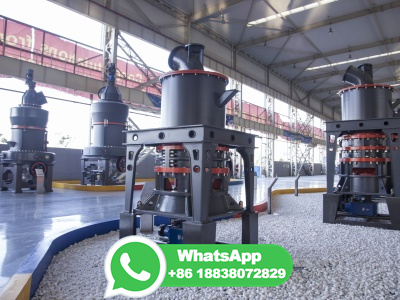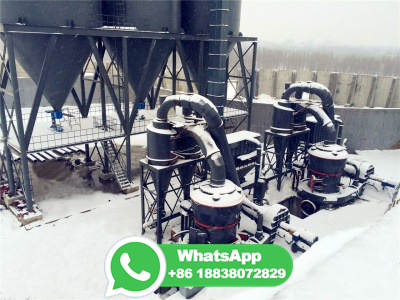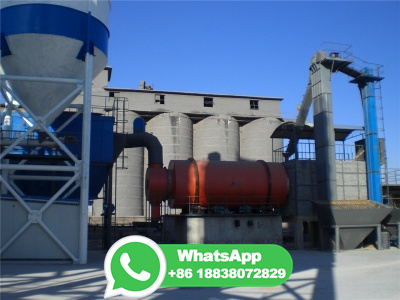
WEBThe slow process of conversion of plants into coal is calledcarbonization. (a) The slow process of conversion of dead vegetation into coal is called ___. (b) Coal and petroleum are formed from the dead remains of organisms and are known as ___. (d) During the processing of coal to get coke, coal tar and ___ are also obtained.
WhatsApp: +86 18203695377
WEBFeb 10, 2020 · The formation of coal from plant matter requires the climate to be warm enough for sustaining plant growth and wet enough to cause partial decomposition of the dead plants and preserve the peat. As time went by, these buried but preserved peat went deeper and deeper under the earth's surface as flooding of the lowlying areas deposited ...
WhatsApp: +86 18203695377
WEBOct 19, 2023 · With more heat, time, and pressure, the kerogen underwent a process called agenesis, and transformed into hydrocarbons. Hydrocarbons are simply chemicals made up of hydrogen and carbon. Different combinations of heat and pressure can create different forms of hydrocarbons. Some other examples are coal, peat, and .
WhatsApp: +86 18203695377
WEBOct 19, 2023 · Coal oil is made by heating cannel coal with a controlled amount of oxygen, a process called pyrolysis. Coal oil was used primarily as fuel for streetlights and other illumination. The widespread use of kerosene reduced the use of coal oil in the 20th century. Coking coal is used in largescale industrial processes.
WhatsApp: +86 18203695377
WEBCrude oil, coal and gas are fossil fuels close fossil fuel Natural, finite fuel formed from the remains of living organisms, eg oil, coal and natural gas.. They were formed over millions of years ...
WhatsApp: +86 18203695377
WEBJun 5, 2024 · The formation of coal occurs over millions of years via a process known as carbonation. In this process, dead vegetation is converted into coal which is found to be carbonrich under very high temperature and pressure. Complete step by step solution: Coal is also called as black gold. Now let's discuss about how coal is formed.
WhatsApp: +86 18203695377
WEBAug 16, 2017 · Ground cracks caused by coal mining is a typical manmade geological hazard which severely damages the ecological environment and ground structures (such as buildings, pipelines and bridges, etc.). Therefore, it is necessary to study ground crack development law in order to fully understand the mechanism of ground crack formation .
WhatsApp: +86 18203695377
WEBMay 29, 2021 · Answer. (a) Fossil fuels are coal, petroleum and natural gas. (b) Process of separation of different constituents from petroleum is called refining. (c) Least polluting fuel for vehicles is CNG. 5. Tick True/False against the following statements. (a) Fossil fuels can be made in the laboratory.
WhatsApp: +86 18203695377
WEBThe majority of diamond deposits found in commercial mines were formed deep within the Earth's mantle. The conditions for diamonds to form are very specific (you can think of it as a baking recipe) and it takes place in an area called "diamond stability zone". Diamond stability zones are usually loed in the upper mantle of the Earth ...
WhatsApp: +86 18203695377
WEBOct 19, 2023 · Fossil fuels are made from decomposing plants and animals. These fuels are found in Earth's crust and contain carbon and hydrogen, which can be burned for energy. Coal, oil, and natural gas are examples of fossil fuels. Coal is a material usually found in sedimentary rock deposits where rock and dead plant and animal matter are piled up in .
WhatsApp: +86 18203695377
WEBIn this way, first lignite (also called 'brown coal'), then subbituminous coal, bituminous coal, and lastly anthracite (also called 'hard' or 'black' coal) may be formed. The wide, shallow seas of the Carboniferous Period provided ideal conditions for coal formation, although coal was formed in most geological periods.
WhatsApp: +86 18203695377
WEBFeb 5, 2013 · All coals, regardless of whether they are caking or coking coals, leave a solid carbonaceous residue at the end of the carbonization process. Chars, if heattreated to extreme temperatures, ≥2500 °C, do not form graphite, while cokes do. That is, chars are nongraphitizable, while cokes are graphitizable [A]. Type.
WhatsApp: +86 18203695377
WEBThis process of separation of various constituents of petroleum is called petroleum refining. This is done in oil refineries. It is a threestep process. The first step is separation where the crude oil is separated into various components through the distillation process. The heavier constituents remain settled at the bottom whereas lighter ...
WhatsApp: +86 18203695377
WEBOct 19, 2023 · Fossil fuels are made from decomposing plants and animals. These fuels are found in Earth's crust and contain carbon and hydrogen, which can be burned for energy. Coal, oil, and natural gas are examples of fossil fuels. Coal is a material usually found in sedimentary rock deposits where rock and dead plant and animal matter are .
WhatsApp: +86 18203695377
WEBStudy with Quizlet and memorize flashcards containing terms like Which of these can be considered a system? Check all that apply., Read the paragraph, and then answer the question. Coal is a black, hard substance formed from the remains of living things that existed a long time ago. The remains were buried and exposed to pressure and .
WhatsApp: +86 18203695377
WEBJan 1, 2016 · The coalifiion process produces water and carbon dioxide during lignite and lowrank coal formation, while in lowrank bituminous coals with more than 29 % volatile matter, mainly carbon dioxide is evolved followed by methane with small amount of heavier hydrocarbons, carbon monoxide, and nitrogen. As the lowrank coal is .
WhatsApp: +86 18203695377
WEBOct 4, 2019 · Answer: Coal and petroleum are formed from the dead remains of living organisms that is why they are called fossils fuels. Question 5. Give two characteristics of coal. Answer: Coal is hard and is of black in colour. Question 6. .
WhatsApp: +86 18203695377
WEBCoke is a fuel used in the steelmaking process that is created by heating coal in the absence of air. Myth: The process of coke manufacturing is very complex and cannot be understood by anyone other than a scientist or engineer. Reality: The manufacturing of coke involves a number of different processes. An understanding of these processes ...
WhatsApp: +86 18203695377
WEBDec 10, 2023 · Stage one in coal production is peat. Peat is a fibrous substance that is oxidized by water and carbon dioxide. When a plant dies, and stays under water, it builds up an accumulation of peat. Peat, when burned, produces a lot of smoke and a large flame and therefore is rarely used as a heat source. Stage two of the coal formation process is ...
WhatsApp: +86 18203695377
WEBAug 9, 2023 · Coal to Liquids Technology. Coal to Liquids (CTL) technology is a pioneering process that holds the potential to revolutionize the way we access and utilize energy resources. By converting coal, a vast and abundant fossil fuel, into liquid fuels such as diesel and gasoline, CTL offers a promising alternative to conventional petroleum sources.
WhatsApp: +86 18203695377
: Fossil Fuel Types and Formation; : Consumption; Fossil fuels is the term given to energy sources with a high hydrocarbon content (see Chapter 1 for a review of hydrocarbon molecules) found in the Earth's crust that formed in the geologic past and can be burned to release their energy. They were formed from prehistoric plants and animals .
WhatsApp: +86 18203695377
WEBJul 3, 2023 · The slow process by which the dead plants buried deep under the earth have become coal is called coal was formed from remains of plants therefore coal is called a fossil fuel. When heated in air,coal burns and produce,mainly carbon dioxide lot of heat energy is also produced during the burning of coal.
WhatsApp: +86 18203695377
WEBAs more soil got deposited over them, they were compressed. The temperature also rose as they sank deeper and deeper. Under high pressure and high temperature, dead plants got slowly converted to coal. As coal contains mainly carbon, the slow process of conversion of dead vegetation into coal is called carbonization. Suggest Corrections.
WhatsApp: +86 18203695377
WEBThis behavior is contrary to what is associated with coal formation. In the case of terrestrial burial, the organic sediment is dominated by cellulose and lignin and the fraction of minerals is much smaller. ... ones) and the heavier ones fall towards the bottom. Because this process occurs at atmospheric pressure, it may be called atmospheric ...
WhatsApp: +86 18203695377
WEBThe slow process by which the dead plants buried under the Earth have become coal is called as carbonisation. Since coal was formed from the remains of the plants, it is called a fossil fuel. Coal, which is mainly carbon, on heating produces mainly carbon dioxide gas and a lot of heat energy.
WhatsApp: +86 18203695377
WEBAug 20, 2020 · The main contributors to sedimentary rock formation are erosion, precipitation, or natural weathering; as well as lithifiion and dissolution. Some of the more common types of sedimentary rock include sandstone, shale, limestone and coal. There are two types of sedimentary rocks, referred to as either detritus or chemical.
WhatsApp: +86 18203695377
WEBDec 13, 2023 · There are three main types of rocks: sedimentary, igneous, and metamorphic. Each of these rocks are formed by physical changes—such as melting, cooling, eroding, compacting, or deforming —that are part of the rock cycle. Sedimentary rocks are formed from pieces of other existing rock or organic material. There are three .
WhatsApp: +86 18203695377
WEBApr 16, 2024 · Answer. Petroleum was formed from plants and animals living in sea. When they died, their bodies settled at bottom of ocean. These get covered with sand and clay. Due to high temperature, high pressure and absence of air. in millions of years, these dead organisms get converted into petroleum. Next: NCERT Question 9 Important → Go .
WhatsApp: +86 18203695377
WEBFeb 22, 2023 · The shock wave of a coal and gas outburst is a highpressure and highspeed impact airflow formed rapidly after the outburst. The propagation destroys the ventilation facilities and causes the destruction of the ventilation system. The theoretical research on the outburst shock wave is of great significance. In order to deeply .
WhatsApp: +86 18203695377
WEBExplanation: The coal is classified on the basis of its physical and chemical composition. The proximate and ultimate analyses are the common tests which are used to find the commercial value of the coal. The proximate analysis gives characteristics of coal such as percentage of moisture, ash and volatile matter.
WhatsApp: +86 18203695377
WEBFeb 14, 2024 · Sedimentary rocks are one of the three major types of rocks found on Earth, alongside igneous and metamorphic rocks. They are unique in their formation process, which involves the deposition, compaction, and cementation of sediment. This contrasts significantly with igneous rocks, which form from the cooling and solidifiion of magma .
WhatsApp: +86 18203695377
WEBThe uses of fractional distillation are that it enables component separation into different phases and purifiion of organic compounds. In coal and petroleum class 8 notes, the classifiion of natural resources, the formation of petroleum and coal and the refining of petroleum along with class 8 Science chapter 5 MCQs are discussed.
WhatsApp: +86 18203695377
WEBJun 8, 2023 · As coal contains mainly carbon, the slow process of conversion of dead vegetation into coal is called carbonisation. Question 4: Fill in the blanks. (a) Fossil fuels are _____, _____, and _____ . (b) Process of separation of different constituents from petroleum is called _____ . ... Question 8: Explain the process of formation of petroleum.
WhatsApp: +86 18203695377